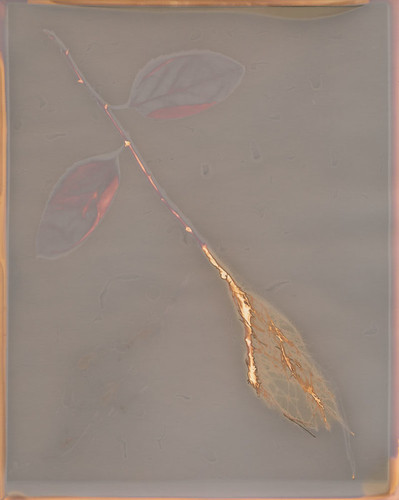 |
| Original Print |
However, I got a bit of a surprise when I did a fix test on a sheet of Adox MCC 110 Premium FB paper. The image was nice enough before fixing, with a grey field and rusty orange highlights. The fixed image was much softer, with a grey-brown field and more golden highlights. The weirdness was that in the fixed image, shades of maroon appeared in areas that had formerly been just bland grey. The leaves, the stem and the border all became much more visually interesting in the fixed print than they had been in the original.
 |
| Post-Fix Print |
That was pretty cool. It wasn't perfect, because the fixer had reduced the contrast with the background and taken some of the drama away from the roots by softening the colors. It also lightened everything, even the dark shadows. Looking at the two images side-by-side on my screen, I realized something: I could just put them together.
In a traditional photograph, I could bracket to get the sky properly exposed in one shot, and the foreground properly exposed in the next. There was no reason that I couldn't do the same thing here, with this lumen print. I've digitally modified lumens before to enhance contrast, clean up the scan, repair damage or make a pale print more vibrant. I've never really taken it that far, because I tend to treat my lumens as a process rather than a final product. There's really no reason to do that,
 |
| Final Composite Print |
So I dropped the Post-Fix file into the Original Print file as a layer, slapped a black mask onto it and cut holes so the leaves, stem and parts of the border would show the extra colors created in the Post-Fix file. A little bit of blending finished the merge, and I got a single image with the best aspects of both the Original Print and the Post-Fix print. A digital hybrid that shows a single image in its best light.
I think there's a lot more room to explore here.
No comments:
Post a Comment